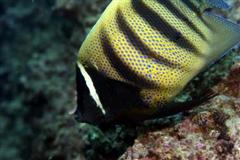Angelfish - Six Bar
Six Striped Angelfish, Six Banded Angel Fish Scientific Name: Euxiphipops sexstriatus
Mon, 28th April, 2025 - 9:26 am GMT
Sponsor Ads:

Alternative Name
Six Striped Angelfish, Six Banded Angel Fish Scientific Name: Euxiphipops sexstriatusBasic Info
The Six Bar Angel can grow to about 18 inches (46 centimeters) in length, though most captive fish grow to about 12 inches (30 centimeters). As their name suggests, young Six Bar Angels are boldly marked with six light colored vertical bars. Mature specimens have black or brown bars over a lighter basic coloration, ranging from silver white to cream colored. Often, blue dots may speckle the entire body, obscured by the bands.
Health
A single Six Bar Angel should have an enclosure of at least 100 gallons. The temperature should remain between 75 and 78 degrees Fahrenheit (24 to 26 degrees Celsius). The pH level should remain at 8.3 or 8.4. The specific gravity should be between 1.020 and 1.025. The lower end of this range, below 1.023, would be appropriate for a single fish. However, because invertebrates require higher salinities, a Six Bar Angel kept with these animals should have a specific gravity between 1.023 and 1.025. Six Bar Angels should be allowed plenty of hiding places. They normally do not get along well with other Angels of the same species, or with similar species. In a reef aquarium, Six Bar Angels may nibble on hard and soft corals or tridacnid clams. The most important aspect of a Six Bar Angel's diet is variety. Often, people offer mysid shrimp, various seaweeds, squid, shellfish, sponges, and numerous protein items. Many Six Bar Angels will also graze on algal growth in their enclosures. In order to ensure an easier transition into a captive environment, it is best to acquire a Six Bar Angel that is not too large. Usually a young, though not tiny, specimen has the best chances of adapting to your aquarium.Habitat
Saltwater fishBehavior
The Six Bar Angel Fish can be difficult to care for, maintaining a healthy Six Bar Angel can be both a challenge and a rewarding task. In the wild, Six Bar Angels are quite omnivorous. They have been known to eat fish eggs, sponges, worms, and mollusks, among a number of other foods. In captivity, a varied diet is also important. One of the larger Angels offered in the pet trade, Six Bar Angels are often considered the hardiest species of Euxiphipops. This does not mean, however, that they are hardy compared to other saltwater fish or even other Angels, or that they should be kept by beginners. Many experienced aquarists consider keeping a Six Bar Angel to be a rewarding achievement. A large aquarium and hiding places are important for stress reduction. Good water quality is also important; in fact, it is reported that Six Bar Angels may brighten in color after water changes. Six Bar Angels normally do not get along well with other large Angels. They may also nip at the mantles of tridacnid clams, or nibble at hard and soft corals. For this reason, they are not considered reef safe. Because of their tendencies to graze on algae in their enclosures, Six Bar Angels should be introduced into well-established aquariums.Origin
Indo-PacificHistory
Six Bar Angels are native to the western Pacific Ocean. They are often seen and collected in Australia, the Solomon Islands, the Philippine Islands, Indonesia, Sri Lanka, and Singapore.Common Foods
N/ASponsor Ads:
Get too many irons in your fire and you'll put it out. -- Unknown
Angelfish - Six Bar
Coded by: BGID® | ALL RIGHTS RESERVED Copyright © 2000-2025
Disclaimer | Privacy | Report Errors / Contact | Credits


 Why haven't we as a collective earth met with aliens yet?
Why haven't we as a collective earth met with aliens yet?  The Best Text Adventure You Will Ever Play! The official site:
The Best Text Adventure You Will Ever Play! The official site:  Homosexual behavior stems from the mind or genetics?
Homosexual behavior stems from the mind or genetics?  World EcoSystem - Biodiversity Changes - Who is on board and who isn
World EcoSystem - Biodiversity Changes - Who is on board and who isn  Mouthwash - Mouthrinse - Mouth Sores - Healing Infections - Gingivitis
Mouthwash - Mouthrinse - Mouth Sores - Healing Infections - Gingivitis  Treatment for Depression
Treatment for Depression  Ultra radical and violent Islamist group that even rivals Al Qaeda
Ultra radical and violent Islamist group that even rivals Al Qaeda  An idea to have teachers who want to carry guns to school undergo some level of police training will be left up to local school districts and police departments.
An idea to have teachers who want to carry guns to school undergo some level of police training will be left up to local school districts and police departments.